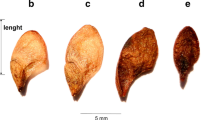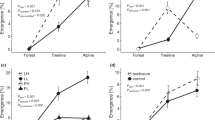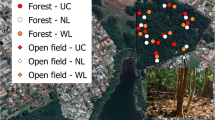Abstract
Relative dispersibility of Tilia americana L., Acer saccharum Marsh. and Fraxinus pennsylvanica Marsh, was inferred from the ratio among species-specific regression coefficients (β) computed from seedling density-distance plots. Density counts were made in spatially-uniform old fields adjacent to single seed sources or monotypic fencerows. Resultant seedling shadow curves approximate the negative exponential form expected for many seeds (log y=a−βX). This basic curve shape fit species of differing dispersibility, dispersal under a range of wind directions and one-year-old or all-aged cohorts. The ratios of β were 1:2.6:3.2 for Tilia, Acer and Fraxinus, respectively, in order of increasing dispersibility. Vegetation patches isolated from seed sources by several hundred meters or more should have extremely low input of seeds, especially Tilia and Acer.
The finding that Fraxinus disperses farther than Acer was unexpected, since the samaras of the former have faster terminal velocities. The relationship can be explained by better performance of Fraxinus samaras in the stronger winds experienced by trees in open landscapes, poorer formation of the samara abscission layer, and release of samaras following leaf abscission and during the winter when winds are the strongest. Both the samara plan and dispersal phenology need to be considered in estimating relative dispersibility among species.
Similar content being viewed by others
Literature cited
Augspurger, C.K. and Franson, S.E. 1987. Wind dispersal of artificial fruits varying in mass, area and morphology. Ecology 68(1): 27–42.
Benzie, J.W. 1959. Sugar maple and yellow birch seed dispersal from a fully stocked stand of mature northern hardwoods in the Upper Peninsula of Michigan. Technical note 561. Lake States For. Expt. Sta. USDA - Forest Service, 1 pp.
Burgess, R.L. and Sharpe, D.M. (eds.) 1981. Forest island dynamics in man-dominated landscapes. Springer-Verlag, New York. 310 pp.
Christiansen, F.B. and Fenchel, T.M. 1977. Theories of populations in biological communities. Springer-Verlag, New York. 140 pp.
Curtis, J.T. 1956. The modification of mid-latitude grasslands and forests by man. In Man's Role in Changing the Face of the Earth, pp. 721–736. Edited by W.L. Thomas. University of Chicago Press, Chicago.
DeAngelis, D.L., Travis, C.C. and Post, W.M. 1979. Persistence and stability of seed-dispersed species in a patchy environment. Theor. Pop. Biol. 16: 107–125.
Dirzo, R. and Dominguez, C.A. 1986. Seed shadows, seed predation and the advantages of dispersal. In: Frugivores and seed dispersal, pp. 237–249. Edited by E. Estrada and T.F. Fleming. Dr W. Junk Publishers, Dordrecht, Boston, Lancaster.
Forman, R.T.T. and Godron, M. 1986. Landscape ecology. J. Wiley and Sons, London. 619 pp.
Franklin, J.F. and Smith, C.E. 1974. Seeding habits of upperslope tree species II. Dispersal of a mountain hemlock seed crop on a clearcut. USDA For. Serv. Res. Note PNW-214, Portland, Oregon. 9 pp.
Green, D.S. 1980. The terminal velocity and dispersal of spinning samaras. Am. J. Bot. 67: 1218–1224.
Green, D.S. 1983. The efficacy of dispersal in relation to safe site density. Oecologia (Berlin) 56: 356–358.
Harper, J. 1977. Population biology of plants. Academic Press, New York. 892 pp.
Holthuijzen, A.M.A. and Sharik, T.L. 1985. The red cedar (Juniperus virginiana L.) seed shadow along a fenceline. Am. Midl. Nat. 113: 200–202.
Isaac, I.A. 1930. Seed flight in the Douglas fir region. J. For. 28: 492–499.
Johnson, W.C. and Adkisson, C.S. 1985. Dispersal of beech nuts by blue jays in fragmented landscapes. Am. Midl. Nat. 113:319–324.
Johnson, W.C., Sharpe, D.M., DeAngelis, D.L., Fields, D.E. and Olson, R.J. 1981. Modeling seed dispersal and forest island dynamics. In: Forest Island Dynamics in Man-dominated Landscapes. Springer-Verlag, New York.
Levin, S.A. 1977. Population dynamic models in heterogeneous environments. Ann. Rev. Ecol. Syst. 7: 287–310.
Levins, R. and Culver, D. 1971. Regional co-existence of species and competition between rare species. Proc. Natl. Acad. Sci. 68: 1246–1248.
MacArthur, R.H. and Wilson, E.O. 1967. The theory of island biogeography. Princeton Univ. Press, Princeton. 203 pp.
McClanahan, T.R. 1986. Seed dispersal from vegetation islands. Ecol. Modeling 32: 301–309.
McCutchen, C.W. 1977. The spinning rotation of ash and tulip tree samaras. Science 197: 691–692.
McDonnell, M.J. and Stiles, E.W. 1983. The structural complexity of old field vegetation and the recruitment of bird-dispersed plant species. Oecologia (Berlin) 56: 109–116.
Middleton, J. and Merriam, G. 1983. Distribution of woodland species in farmland woods. J. Appl. Ecol. 20: 625–644.
National Oceanic and Atmospheric Administration. 1977. Local Climatological Data - Monthly summary. October 1977, Milwaukee, Wisconsin. 2 pp.
National Oceanic and Atmospheric Administration. 1978. Climatography of the United States No. 90 (1965–1974). Airport climatological summary, Milwaukee, Wisconsin. General Mitchell Field. 18 pp.
Noble, D.L.and Ronco, F. 1978. Seedfall and establishment of Engelmann spruce and subalpine fir in clearcut openings in Colorado. Research Paper RM-200. Rocky Mountain Forest and Range Experiment Station, USDA-Forest Service. 12 pp.
Randall, A.G. 1974. Seed dispersal into two spruce-fir clearcuts in eastern Maine. Res. Life Sci. 21: 1–15.
Risser, P.C., Karr, J.R. and Forman, R.T.T. 1984. Landscape ecology - directions and approaches. Ill. Nat. Hist. Surv. Spec. Publ. No. 2. Champaign, Il. 18 pp.
Ronco, F. and Noble, D.L. 1971. Englemann spruce regeneration in clearcut openings not insured by record seed crop. J. For. 69(9): 578–579.
Schopmeyer, C.S. 1974. Seeds of woody plants in the United States. USDA Agric. Handbook 450, Washington, DC, 383 pp.
Sharpe, D.M. and Fields, D.E. 1982. Integrating the effects of climate and seed fall velocities on seed dispersal by wind: a model and application. Ecol. Modeling 17: 297–310.
Siggins, H. 1933. Distribution and rate of fall of conifer seeds. J. Agric. Res. 47: 119–128.
Smith, A.J. 1975. Invasion and ecesis of bird-disseminated woody plants in a temperate forest sere. Ecology 56: 19–34.
Stergios, B.C. 1976. Achene production, dispersal, seed germination, and seedling establishment of Hieracium aurantiacum in an abandoned field community. Can. J. Bot. 54: 1189–1197.
Werner, P.A. 1975. A seed trap for determining patterns of seed deposition in terrestrial plants. Can. J. Bot. 53: 810–813.
Author information
Authors and Affiliations
Rights and permissions
About this article
Cite this article
Johnson, W.C. Estimating dispersibility of Acer, Fraxinus and Tilia in fragmented landscapes from patterns of seedling establishment. Landscape Ecol 1, 175–187 (1988). https://doi.org/10.1007/BF00162743
Issue Date:
DOI: https://doi.org/10.1007/BF00162743




